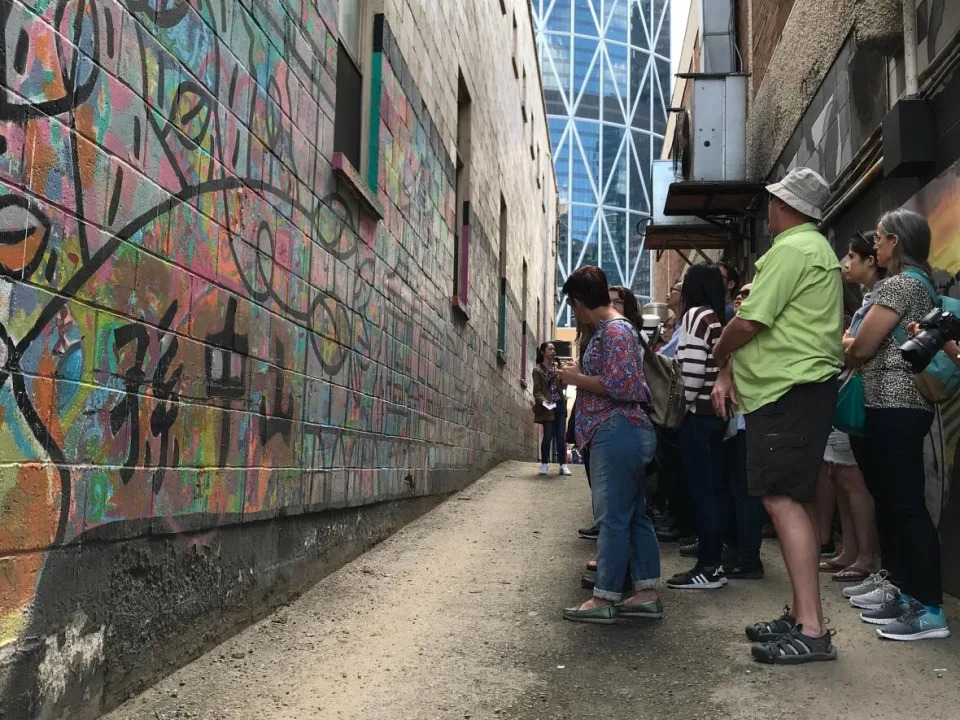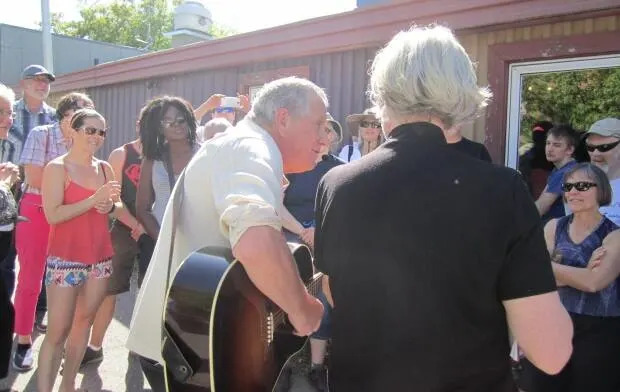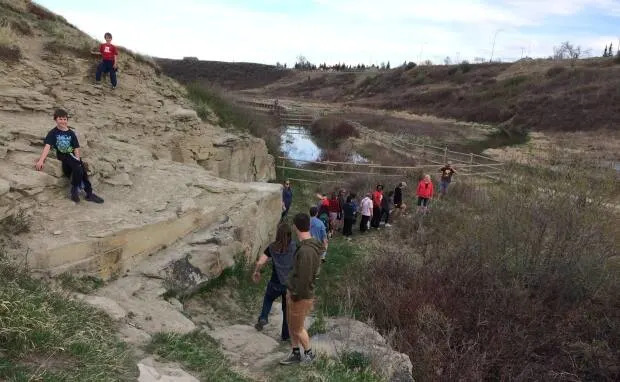CBC
Wed, April 5, 2023

A Jane's Walk focused on some of the murals in Calgary in 2018.
(Submitted by Amani Khatu - image credit)
From a tour of shooting locations used by HBO's The Last of Us, to an urban wildlife exploration of Weaselhead Flats, to a literary journey discovering the novelists, poets and publishers who've lived in Elbow Park.
Jane's Walks are volunteer-led walking tours, offering people an opportunity to explore their community through a new lens.
The annual walks are named after Jane Jacobs, an urbanist and activist who encouraged people to get out into their neighbourhoods.
The walks are held globally each May, with organizers in Calgary hoping to get back to full offerings after scaling back in recent years due to the pandemic.
"We are hoping to have around 40 walks, but [in] one year we had like 82," said Awani Khatu, community activator at the Federation of Calgary Communities, in an interview on the Calgary Eyeopener.
"We want to get that momentum back. We want to get people. Even if you're in the suburbs, we definitely want you hosting a walk as well. This isn't just restricted to people in the inner core."
The group is putting out a call for more walk leaders — people passionate about an aspect of the city they're willing to tell others about.
Bob Chartier started his walk of Calgary's Music Mile in Inglewood about seven years ago. It runs along Ninth Avenue S.E. from the King Eddy to The Blues Can, including stops at the National Music Centre, the CKUA radio station and the Ironwood.
He finishes off the tour with his own song about the Music Mile.
"The Jane's Walk idea is the coolest thing in the world. It says that everywhere you go that neighbourhoods are interesting.… You just need some great stories and just say, 'Come on a walk with me through this neighbourhood and I'll tell you why I like it,'" he said.

Submitted by Awani Khatu
Chartier is a later-comer singer-songwriter and musician, and he's spent time getting to know people up and down the avenue. So he says he speaks from the heart.
"It's not a scripted walk with me," he said.
"I think what people get out of it is not only a classic urban walk, but they get introduced to the notion that, 'Hey, this is an arts district that was made from the ground up."
How to lead a walk
Khatu says a great conversation, not a scripted lecture, is exactly what they're looking for, whether you're interested in art, architecture or even dogs.
"It can be like a walking tour with all the neighborhood four-legged friends and you go to the local dog park. So it can really be on anything that you want," she said.
"The great thing about being on your feet is that you get to pause whenever you need to pause. And if there's a detour, like take it, you know, go and explore. It's about the journey, not the destination."

Submitted by Awani Khatu
Some other walks scheduled for the May 5-7 event are focused on gardens, astrophysics and neighbourhood history.
Walk leaders just need to submit a form on the federation's website, providing a walk summary, accessibility considerations and a short bio.
The deadline to apply is April 22, although Khatu says that may be extended.
"If you want to have fun, this is for you."
From a tour of shooting locations used by HBO's The Last of Us, to an urban wildlife exploration of Weaselhead Flats, to a literary journey discovering the novelists, poets and publishers who've lived in Elbow Park.
Jane's Walks are volunteer-led walking tours, offering people an opportunity to explore their community through a new lens.
The annual walks are named after Jane Jacobs, an urbanist and activist who encouraged people to get out into their neighbourhoods.
The walks are held globally each May, with organizers in Calgary hoping to get back to full offerings after scaling back in recent years due to the pandemic.
"We are hoping to have around 40 walks, but [in] one year we had like 82," said Awani Khatu, community activator at the Federation of Calgary Communities, in an interview on the Calgary Eyeopener.
"We want to get that momentum back. We want to get people. Even if you're in the suburbs, we definitely want you hosting a walk as well. This isn't just restricted to people in the inner core."
The group is putting out a call for more walk leaders — people passionate about an aspect of the city they're willing to tell others about.
Bob Chartier started his walk of Calgary's Music Mile in Inglewood about seven years ago. It runs along Ninth Avenue S.E. from the King Eddy to The Blues Can, including stops at the National Music Centre, the CKUA radio station and the Ironwood.
He finishes off the tour with his own song about the Music Mile.
"The Jane's Walk idea is the coolest thing in the world. It says that everywhere you go that neighbourhoods are interesting.… You just need some great stories and just say, 'Come on a walk with me through this neighbourhood and I'll tell you why I like it,'" he said.

Submitted by Awani Khatu
Chartier is a later-comer singer-songwriter and musician, and he's spent time getting to know people up and down the avenue. So he says he speaks from the heart.
"It's not a scripted walk with me," he said.
"I think what people get out of it is not only a classic urban walk, but they get introduced to the notion that, 'Hey, this is an arts district that was made from the ground up."
How to lead a walk
Khatu says a great conversation, not a scripted lecture, is exactly what they're looking for, whether you're interested in art, architecture or even dogs.
"It can be like a walking tour with all the neighborhood four-legged friends and you go to the local dog park. So it can really be on anything that you want," she said.
"The great thing about being on your feet is that you get to pause whenever you need to pause. And if there's a detour, like take it, you know, go and explore. It's about the journey, not the destination."

Submitted by Awani Khatu
Some other walks scheduled for the May 5-7 event are focused on gardens, astrophysics and neighbourhood history.
Walk leaders just need to submit a form on the federation's website, providing a walk summary, accessibility considerations and a short bio.
The deadline to apply is April 22, although Khatu says that may be extended.
"If you want to have fun, this is for you."
EDMONTON JANES WALK: Jane's Walk YEG – Walk Together. (wordpress.com)
PDF







